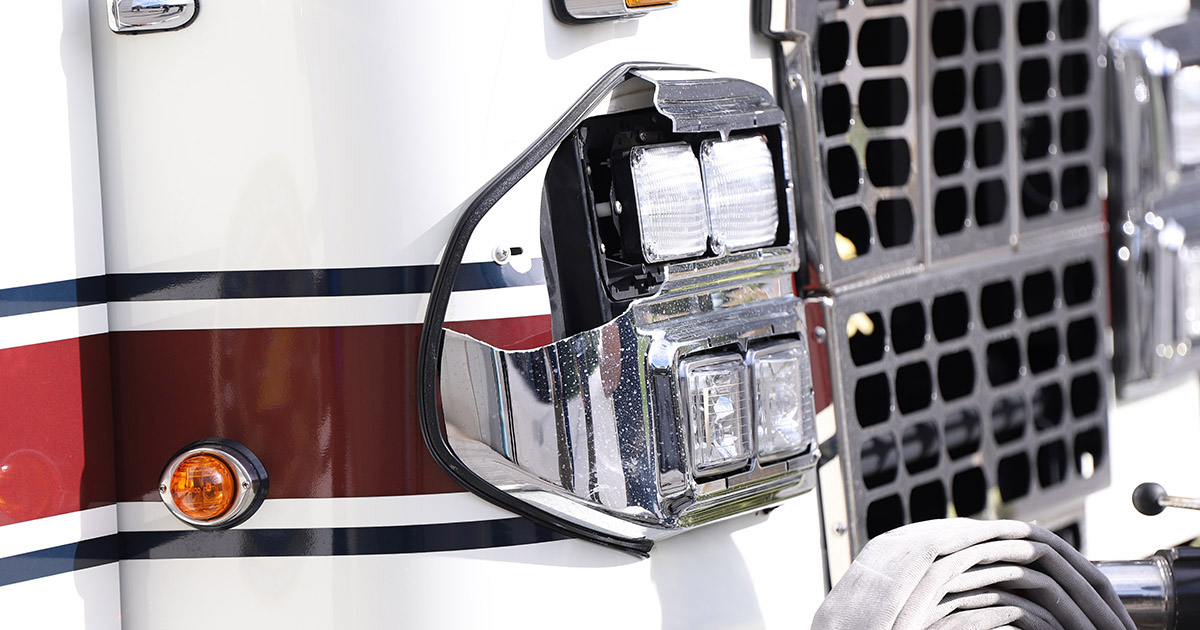We’re answering the #1 question we get about insuring emergency services vehicles—and explaining why it’s an important term for emergency services leaders, board members and their insurance brokers to understand.
Imagine that your primary pumper is the victim of a distracted driver and it’s damaged beyond repair. While insurance may seem like a boring piece of paper—it could mean the difference between getting a similar replacement apparatus as soon as possible or having to partner with a neighboring department to answer calls for the indefinite future.
Your emergency service organization’s vehicles do more than transport people from place to place. They transport responders to emergencies where your community members are counting on you.
That’s why it’s important to partner with an insurance provider who understands the types of vehicles your ESO utilizes (like knowing the difference between a type 1, 2 and 3 ambulance), appreciates the services your vehicles help you provide and designs insurance products to help address your unique needs.
One of the ways that VFIS addresses the particular operations of fire and EMS agencies is by offering agreed value coverage for their vehicles. However, because it’s truly a specialized concept, we tend to get questions about it…a lot of them.
We sat down with Peter Feid, VFIS Sales Executive, and Mike Baker, Director of Client Risk Solutions, for an episode of the Don’t Risk It! podcast to chat about what you should know about insuring emergency vehicles and agreed value. Here are key takeaways you should know.
3 Things you should know about agreed value:
1. What is agreed value?
For many VFIS clients, the agreed value form that’s attached to their auto policy is usually the first time they see this term. And if it’s an insurance agent’s first time working with us, it may be the first time they need to address agreed value in this capacity as well.
Agreed value addresses physical damage to VFIS clients’ vehicles and allows you to pick a value to insure each of your vehicles for. (This differs from auto liability coverage which helps cover the costs of damages to the others’ property, as well as any bodily injuries, for those found to be at-fault for auto-related incidences.)
Wondering why you don’t hear “agreed value” more often? That’s because it was originally developed to address the needs of antique and collector vehicles. While the similarities between a 64’ Aston Martin DB5 and 22’ Pierce ladder truck may not be obvious at first glance, they actually do have some important (insurance related) qualities in common. These types of vehicles are both typically high-value, special-use and the people who have them care about them—so they’re well-maintained. And that’s what led VFIS to adopt the term and coverage-style to address unique needs of fire apparatus, ambulances and other fire and EMS vehicles.
2. What's the advantage of agreed value for emergency service organizations?
Agreed value eliminates many of the downsides that emergency service organizations may experience from traditional auto policies. For example, our agreed value policy does not include terms like:
- Coinsurance—where a vehicle is insured for a percentage of its total cash or replacement value.
- Depreciation—an assumption that your vehicle’s value declines during your possession.
- Actual cash value—the amount required to replace your vehicle minus depreciation, at the time of the loss.
- Betterment clauses—stipulates that if the repair or replacement of the damaged parts results in a vehicle that is “better than” your original vehicle at the time of loss, the insurers will not pay for this net improvement.
Instead, you pick how much you’d like to insure each of your vehicles for. So, should an incident occur, you already know the exact insured-value of that vehicle, which helps eliminate the guesswork and confusion.
3. What factors should an emergency service organization consider when deciding on agreed value?
Let’s start by saying, we know this isn’t an easy task. It’s time consuming and can take a lot of planning and forward-thinking, like analysis of vehicle rotation and fleet management. However, we hope that the peace of mind you’ll get in return is beyond worth the time you spend and we’re here to help.
For starters, we’ll offer you suggestions as to what to value each vehicle for. But we understand that you know your operations better than anyone else—so, ultimately, it’s up to you to decide.
Steps to help you assign agreed value to your vehicle:
- Pick a team. Decide who will evaluate and establish the agreed value for your vehicles. Maybe it’s your apparatus purchasing committee, board members, leadership team or a combination of those members.
- Evaluate your fleet. Do you have everything you want and need? What are your ultimate goals—and what vehicles are associated with those goals?
- Assess the value of each vehicle. Use the latest research and resources available (like the prices of used and new vehicles from authorized dealers) to help you determine:
- The low-end value for each vehicle. This is also called actual cash/market value—and is the amount you would get for your vehicle if you were to sell it as-is, including any permanently-attached equipment.
- The high-end value for each vehicle. This is what would it cost if you were to purchase a brand-new vehicle with similar specifications.
- Calculate agreed value. Utilizing your findings from your fleet evaluation and vehicle assessments, you can start to determine how much you’d like to insure each vehicle for in regards to physical damages.
Your agreed value team should consider what you would do if each vehicle was damaged beyond repair.
First, it’s important to know that most ESO vehicles are repairable in the majority of auto-related incidents. However, when you’re considering how much to insure each vehicle for, it might be helpful for you to consider what you would do if each of your vehicles was not repairable.
For example, let’s say you’re considering how much to insure an older vehicle for. If it was damaged beyond repair, would you replace it with a similar one? If so, consider insuring it on the lower-value end. Or, would you want a newer used vehicle that has some additional functions? Then you may want to go in the middle. Or, if you want the brand-new and greatest form of that vehicle, you’d probably want to consider insuring it on the higher end. Or, if you wouldn’t replace it at all—you may not want physical damage coverage.
Additional reminders about VFIS' agreed value to keep in mind:
- You will never receive more than the agreed value you have chosen. In the event of a loss—we’ll pay the least of these four options: the cost to repair the damaged property, the cost to replace a part or parts of the damaged property with a part or parts of like kind and quality (without deduction for depreciation), the cost to replace the entire covered auto and its permanently attached equipment with a comparable new auto and permanently attached equipment manufactured to current standards or the agreed value stated in your policy declarations as applicable to the damaged or stolen property.
- That means if your agreed value is too low… If the agreed value is less than the actual cash value of the vehicle, our agreed value coverage could actually penalize you in the event of a loss.
- That means that if your agreed value is too high… A VFIS policy will never pay more than the replacement cost or the agreed value, whichever is less. So, if the agreed value you select is more than the replacement value of the vehicle, you would be paying premium for an amount of coverage you would never be able to collect.
Agreed value updates:
We’re excited to share there are product enhancements coming to VFIS Property + Casualty (P+C) policies, including two related to agreed value:
- Agreed Value trigger reduced from 75% to 60%
Previously, our policy said that a vehicle is considered repairable if it could be repaired for up to 75% of the agreed value. However, that trigger has now been reduced to 60%—meaning that there is now more wiggle-room for vehicles to be replaced (rather than repaired) should substantial damages occur. - Chief Vehicles insured on Agreed Value basis
You can now add your chief vehicles to your agreed value list—and there’s no age limit for vehicles!
Have questions? Your local insurance broker can help!
If you have questions, meet with your insurance agent to get their expertise on your policy and agreed values, and continue to meet with them periodically to help ensure that your insured values are up-to-date and consistent with the goals of your organization. We’re happy to assist your broker with any questions and these considerations may be helpful for them as well!
We hope that these tips are useful—and that, ultimately, our coverage helps to make you as whole as possible in the event of a loss. Check out the Don’t Risk It! podcast series to hear the full episode—and come back bi-weekly to hear the VFIS Risk Solutions Team and special guests discuss the latest risk management best practices in fire and emergency services.
DISCLAIMER
The information contained in this blog post is intended for educational purposes only and is not intended to replace expert advice in connection with the topics presented. Glatfelter specifically disclaims any liability for any act or omission by any person or entity in connection with the preparation, use or implementation of plans, principles, concepts or information contained in this publication.
Glatfelter does not make any representation or warranty, expressed or implied, with respect to the results obtained by the use, adherence or implementation of the material contained in this publication. The implementation of the plans, principles, concepts or materials contained in this publication is not a guarantee that you will achieve a certain desired result. It is strongly recommended that you consult with a professional advisor, architect or other expert prior to the implementation of plans, principles, concepts or materials contained in this publication.
This blog post may contain the content of third parties and links to third party websites. Third party content and websites are owned and operated by an independent party over which Glatfelter has no control. Glatfelter makes no representation, warranty, or guarantee as to the accuracy, completeness, timeliness or reliability of any third party content. References to third party services, processes, products, or other information does not constitute or imply any endorsement, sponsorship or recommendation by Glatfelter, unless expressly stated otherwise.
Related posts
We asked 10 members of our VFIS Team to name one auto-related risk that they believe is underdiscussed in fire and EMS agencies. Here’s what they said.
Most volunteer fire departments rely heavily on POVs, but there are inherent risks you should know.
Establish a Emergency Vehicle Operations Program that includes driver/operator requirements to help ensure your vehicles are in the right hands.










Submit a Comment